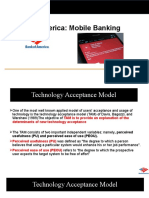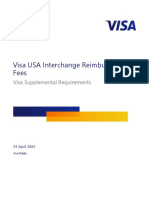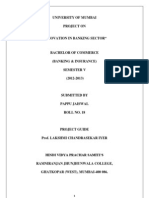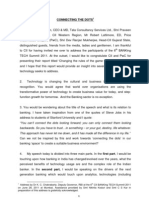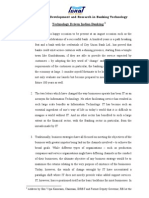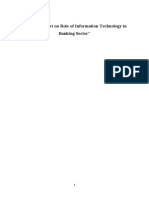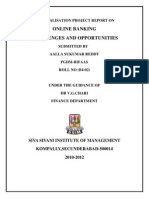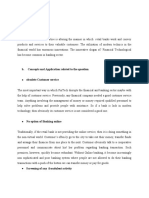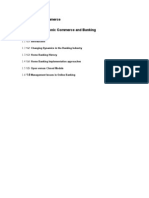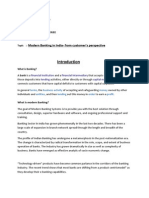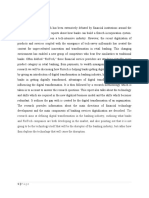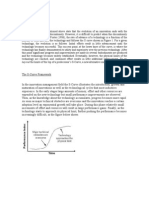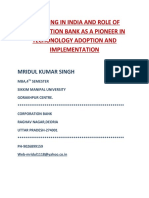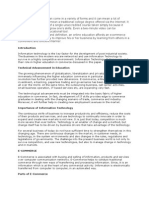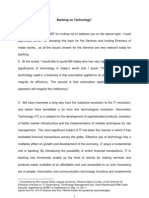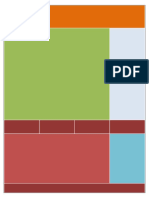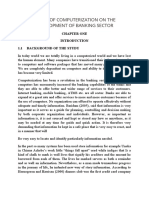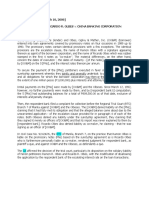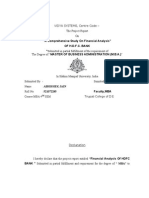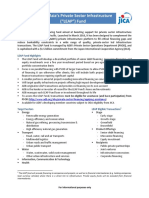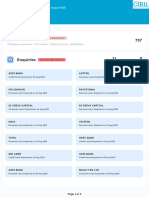K C Chakrabarty: Beyond Core Banking Solutions (CBS) - Fast Forward To Banking 2.0!
K C Chakrabarty: Beyond Core Banking Solutions (CBS) - Fast Forward To Banking 2.0!
Uploaded by
Kuldeep Singh ChauhanCopyright:
Available Formats
K C Chakrabarty: Beyond Core Banking Solutions (CBS) - Fast Forward To Banking 2.0!
K C Chakrabarty: Beyond Core Banking Solutions (CBS) - Fast Forward To Banking 2.0!
Uploaded by
Kuldeep Singh ChauhanOriginal Title
Copyright
Available Formats
Share this document
Did you find this document useful?
Is this content inappropriate?
Copyright:
Available Formats
K C Chakrabarty: Beyond Core Banking Solutions (CBS) - Fast Forward To Banking 2.0!
K C Chakrabarty: Beyond Core Banking Solutions (CBS) - Fast Forward To Banking 2.0!
Uploaded by
Kuldeep Singh ChauhanCopyright:
Available Formats
K C Chakrabarty: Beyond Core Banking Solutions (CBS) fast forward to Banking 2.0!
Address by Dr K C Chakrabarty, Deputy Governor of the Reserve Bank of India, at the Executive Roundtable organised by the Institute for Development and Research in Banking Technology (IDRBT) in collaboration with Union Bank of India, Mumbai, 18 February 2011. * * *
Assistance provided by Smt Nikhila Koduri in preparation of this address is gratefully acknowledged.
1. Shri M V Nair, Chairman & Managing Director, Union Bank of India, Shri B Sambamurthy, Director, IDRBT, Shri S S Mundra, Executive Director, Union Bank of India, Shri M G Sanghvi, Executive Director, Bank of Maharashtra, senior bankers, other distinguished guest, ladies and gentlemen. It is a pleasure to be in your midst today at this Executive Roundtable organised by IDRBT in association with Union Bank of India on the theme Beyond Core Banking. As you may be aware, this is a part of a series of roundtable organised by IDRBT in collaboration with banks on the subject and I am happy to have been associated with some of them. IDRBT has been doing a commendable job in enlarging the role banking technology and research and I do not recall of any other comparable institution in the world. Under Mr Sambamurthys leadership, in keeping with its mandate, it is moving away from transactional areas into more strategic areas and research. 2. The next information revolution is well under way. Peter Drucker in the New Information Revolution has said and I quote The next information revolution is forcing us to redefine what business enterprise actually is the creation of value and wealth. But it is not happening where information scientists, information executives, and the information industry in general are looking for. It is not a revolution in technology, machinery, techniques, software, or speed. It is a revolution in CONCEPTS-internet, web etc. It is age of the Prosumer: producer and consumer of information. This Prosumer is you a web user who creates and uses content and information on the web. So far, for 50 years, the information revolution has centered on data their collection, storage, transmission, analysis, and presentation. It has centered on the T in IT. The next information revolution asks two pertinent questions: What is the meaning of information, and what is its purpose? 3. And this is leading rapidly to redefining the tasks to be done with the help of information, and with it, to redefining the institutions that do these tasks. This holds good for banks also. My address today would be centered on the ways of bringing in the focus of banking to a new level which would be based on a whole new customer service and the significance of a customer-centric strategy. We must understand here that customers want a great banking service, tailored to their needs and in a timeframe that works. I would also touch upon what are the technologies beyond core banking and the business and technological requirements of Financial Inclusion. I would be briefly be touching upon the alignment between business and IT and concluding with the recent initiatives taken by the RBI in the area of technology. Out with the old, in with the new 4. All of us would agree that technology has no longer remained just a means for automating processes. It has revolutionized every industry in the world by rendering faster and cost effective delivery of products and services to customers, who in the normal course could not have afforded the same, and at the same time producers of goods and services would remain viable and profitable. Technology is the surest and most appropriate way of bringing inclusion in respect of any product and/or service.
BIS central bankers speeches
5. Banking services is no different. The major technological innovation in banking was the ATM over 25 years ago, and up until the early 1990s this was the only customer-facing technology that existed. Following this came the phone banking, IVR systems, advent of the internet, increasing complex database mining, and remote distribution channels. While banking and retail financial services are generally considered a traditional business area, the fact is that there have been more changes in this sphere in the last 10 to 15 years than in the preceding 100 years. If I had told you 15 years ago that Google would be one of the largest global brands, you would have said who? If 5 years ago, I had told you the total number of facebook users today would be greater than the physical population of about half countries in the world, you would have said what? In a similar fashion, it is possible that some enterprising corporate incubator will figure out the customer behaviour secret and construct a purpose-built retail bank that would take off like Twitter globally. We are experiencing an age where the impact of internet and mobile devices have made the rules in managing delivery channels and the mode of reaching customers a moving target. How the banks can reach this target would be challenge to be addressed by the banks. 6. I would pose a question here: What came first in this chicken and egg argument technology or customer demand for technology? Does technology change customer behaviour or is it customer demand that influences technology in banking. In the earlier days, it used to be said about banking that: build it and they will come. However this will not hold well in the present day. Technology should work for the business in its aim to make its products and services relevant and accessible to its customers, instead of a fixed sunk cost that sits heavily on a banks P&L account. Technology should also not only be looked as a cost cutting tool but as a value creating opportunity to customers and through this to the organisation. 7. I would like to talk to this august group about the increasing acceptance of technology and innovation in our lives. I would like you to appreciate that while the telephone took approximately 50 years to reach critical mass, television took half of that (2535 years), PCs about 1214 years and, the Internet about just seven years. Ultimately now facebook and twitter are now being adopted not in years but in months. The lesson learnt here is that as we become more used to technology and innovation, it is taking less time to adopt these technologies into our lives, and this further encourages innovation and this, increases the impact on business. What I am trying to say here is that banks have less time to react and anticipate the impact of such changes on their business unless they deliver fast. Navigating rapid change 8. Technological advancement enables a broader and inclusive banking sector and in the process, is a key driver for the sustained and inclusive growth of the economy. Technology by itself is not a panacea. But technology has evolved to such an extent that it can hold the key to achieving your goals if banks are willing to accept the changes that they will need to make to get there. Banks have implemented Core Banking Solutions (CBS) which marked a paradigm shift in more senses than one and branch customers are now bank customers as they can access their accounts from any branch for defined purposes. It was envisaged that the CBS would offer new opportunities for information management, better customer service and improved risk management. However banks have not been able to reap the benefits of this technology in terms of reduction in costs of small value transactions, speed with which the transactions are done if both successful and unsuccessful transactions are considered, improved customer services and effective flow of information within the banks as also to the regulator. Banks have not gained in terms of efficiency partly because the much needed business process re-engineering was not done. Further, banks have deployed technology for transaction processing and the same has not been explored extensively for analytical processing like customer relationship management and decision making. Thus, there is a need to take care of what we could not achieve in the first round of
BIS central bankers speeches
technology implementation and think beyond CBS. Supported by the latest technology, banks would need to identify new business niches, to develop customized services, to implement innovative strategies and to capture new market opportunities. With further globalization, consolidation, deregulation and diversification of the financial industry, the banking sector is set to become even more complex. But successful banks make it simple and those who are able to achieve that will be more successful. It is here that the concepts of Next generation Banking is taking centre stage. There is a need to fast forward to Banking 2.0. Next generation banking 9. Bill Gates has once said Banking is necessary but banks are not. The next generation banking should aim to provide customer-centric features, giving users an extremely personalized experience while at the same time providing increased intelligence and automation to help banks sell appropriate products and services to their customers. Changes in demography and how banks reposition themselves to reap the advantages of demographic dividend will be a crucial deciding factor for the success of bank. The GenNext banks would be providing life cycle wise products and services, right from birth till death, under one roof. The essential idea is that a relationship once built at birth carries on till death and all the products and services are made available under one umbrella. Technologically, next generation banking would mean several interconnected applications and flexible orchestration, driven by business needs, and without a long intermediation cycle. This would call for seamless their customers. Changes in demography and how banks reposition themselves to reap the advantages of demographic dividend will be a crucial deciding factor for the success of bank. The GenNext banks would be providing life cycle wise products and services, right from birth till death, under one roof. The essential idea is that a connectivity across systems and operating units. It would also demand that all this be achieved with costs absolutely under control. The technology that will support this new world must be able to incorporate all these features and more. Our technology adoption was not customer-centric, it was employee-centric. I would like to mention a few illustrative technologies beyond core banking that are likely to which can add value to a bank and gain prominence in the near future are delineated below: Customer Relationship Management: In order to enhance the effectiveness of the various channels such as branch banking, mobile banking, internet banking, Banks may consider the use of a comprehensive Sales Customer Relationship Management (CRM) solution which enables the user to access the entire customer details and provides a 360 degree view across channels and products and enhances service quality. This will enable customer interactions across various touch points (such as a call or email) to be captured on a centralised single system. We need to transit from transaction orientation to customer orientation. Use of Data Analytics (Business Intelligence): Business intelligence (BI) helps a bank decide on various business strategies including customer segments, product mix, channel mix etc. A good data warehouse can also enable call center technologies like outbound dialing to be used for active marketing and sales channels and not just for transactions. Human Resources Management: For medium to large enterprises, an effective Human Resources Management System (HRMS) can bring remarkable efficiencies and handle the various needs of the employees. Such systems can also handle the localised requirements of banks operating in multiple countries. The demographic dividend alluded to earlier not only has implications from customers expectation side but from human resources side as a larger pool of talent is potentially available. Mobile Banking: The fast-paced growth of consumer mobility has made the mobile phone, a channel of choice for last-mile end-user connectivity. The business imperatives of a mobile banking platform include:
BIS central bankers speeches
Mobile presents the lowest per transaction cost for the Bank as compared to other channels. Push-based offers that can be delivered over-the-air and can result in increased offtake of services. Value added services such as Prepaid mobile recharge, funds transfer and bill payment can also be enabled.
Capital Adequacy Framework: In order to meet the requirements of the Capital Adequacy framework, Application Systems are available which provide capability to compute the capital adequacy as per the RBI guidelines with Standardized, Advance internal Ratings Based (AIRB), advanced management approach (AMA) for Operations risk and other management reporting. Thus, credit risk, market risk and operations risk can be measured, simulated and controlled using these systems. Alternate Channel (TV Banking): Today, it is imperative to reach Banking services to the maximum number of households and television is an ubiquitous medium in todays households. TV Banking empowers TV viewers to access banking product/service information at the touch of a button. Treasury systems: As a key component of a banks activities, treasury needs to accorded adequate attention in terms of technology solutions. Integrated platforms for dealing with the broad range of assets including foreign exchange, money market, fixed income and derivatives etc. would be of great value. Such systems may cover the range of functionalities including pricing, booking, risk management, value at risk, limit control, confirmation, payment and accounting etc. More efficient treasury operations and better controls would be the key outcomes of such systems. The right mix 10. As institutions in the banking industry adjust to an altered competitive landscape and a revised set of priorities, the role of the core system is becoming more important. The new era of banking demands a fresh technological approach, as banks must rid themselves of the burden of inflexible solutions designed and implemented when the financial world was a very different place. 11. As might be expected, well-established operational objectives such as increasing revenues and efficiencies while simultaneously decreasing costs remain prominent. Here I would like to draw a parallel to Darwins theory of evolution, as published in his work The Origin of Species that, purports that populations evolve through a process of natural selection, whereby favourable traits become more common and unfavourable traits become less common. Over the time, this process may result in adaptations for particular niches, resulting in the emergence of new species. If we apply this theory to banking systems, we can draw a number of parallels one of them being that unfavourable technologies would become extinct, while newer, more agile and flexible technologies provide competitive edge and will ultimately survive the test. The theory of they (customers) needed the bank more than the bank needed them (customers) is surely undergoing a transformation. Customer imperatives The writing on the wall is clear: keep your customers happy and survive. 12. I would like to dwell on the five customer imperatives that would drive the Next Generation banking: Channel improvement: Banks would need to develop a right mix of assisted and selfservice channels to provide a rich unified and consistent banking experience. Most of the
BIS central bankers speeches
time, customers choose a channel because they do not have a choice. Towards this, banks need to transform their business with a channel strategy with the idea that a customers approach to channels is additive not substitutive. This would result in better communication, better mobility and better customer insight. Service Accessibility: Banks also have opportunities to incorporate technologies which would make banking accessible for a broader base of population. By this I mean banks can look at trends like providing for talking ATMs, provision of Braille statements, ATMs with Braille keyboards, dedicated service line for customers with hearing or speech impairment, setting that allow persons with low vision to customize the internet. Customer serviceability: You would agree with me that today customers can access banking services 24 hours a day, 7 days a week and they can do so in person, over the phone, online and in some places through the television. The growing customer bases are the product of instant gratification. While banks need to balance their service offerings across customer segments, they also need to provide a responsive, reliable and competent service model which offers a uniform level of information and interaction across various channels. Data Privacy and Security: Data privacy is still a relevant area of concern for banking customers despite technological advances and strong risk management processes within the banks not only minimise the financial loss to the customer but also safeguard emotional victimization of customers. Simplified Banking: It would be more meaningful if banks would make banking sophisticated, yet simple, in terms of processes and services, to enhance banking experience. Providing a simplified yet fully loaded banking experience is the need of the hour for banks. Financial inclusion with IT 13. Business requirements: I would like to emphasise that it is imperative to facilitate opening new accounts, provide need based credit, remittance facilities and help promote financial literacy in rural India. It is expected that new technologies and business correspondents will drive this movement. In the long run, it is expected to cover the economic distance between rural and urban India. It is here that technology would play a major role in achieving the objectives set out. For all services that entail payments to citizens, the last mile interface is the weakest link. An efficient payments and transfers system warrants bank connectivity to every individual and institution, including those in remote rural areas. This coupled with building a technological interface for ensuring this would result in creating wonders for Financial Inclusion. 14. Technological requirements: Technology helps the financial institution to go where the customer is, while playing an important role in reducing the operating costs for providing banking services, particularly in remote rural areas. Internet and mobile technologies have spread out and are visible at various levels of the technology delivery chain. But, the challenge hereon, in the context of financial inclusion, would be to get the technology pieces together in a complete whole that is viable and sustainable. All banks should accord top priority to provide connectivity to ensure that banking facilities reach all its customers ubiquitously. Need for a clear strategy and planned approach 15. For a plan to succeed there must be a vision and strategy driving implementation. There is clearly an absence of vision of how technology is going to drive business and customer relationship. Thus technology adoption in banks is a result of external pressures rather than a vision shared by the bank staff percolating right down from right up or a
BIS central bankers speeches
corporate vision of the positive externalities that will result. Consequently, this lack of longterm vision and strategy has impacted the way technology has been utilised. Alignment between business and IT 16. The Business-IT Wall is only a figurative wall, but it literally separates the Business and IT in most organizations today. The success of all enterprise information initiatives requires that this wall be torn down, ending the conflict between the Business and IT, and forging a new collaborative union. Back office centralization 17. Indian banks have been on the forefront of back office technology adoption successfully harnessing the power of information technology to gain operational and strategic advantage. This has been possible largely through the adoption and upgradation of technology in the back office operations. Computerisation of back office operations was envisaged to release manpower for various front office jobs to the satisfaction of the customer. Customers were to get better services at lower direct and indirect costs. But this has not happened the way it was planned. Banks are still involving a sizeable number of their back office staff in the preparation and submission of various returns. There is an urgent need for building an MIS server to generate returns automatically. In this connection, I would like to inform you that the RBI has prepared an approach paper on automated data flow (a straight through process) of information from the core banking solution (CBS) or other IT systems of commercial banks to the Reserve Bank. The approach paper, inter alia, discusses the methodology to be adopted by banks to classify themselves into a cluster based on its technology and process dimensions. Accordingly, banks have been advised to conduct a self-assessment and furnish the estimated timelines for the project. Report on information security, electronic banking, technology risk management and tackling cyber fraud 18. RBI has recently released a report on Information Security, Electronic Banking, Technology Risk Management and Tackling Cyber Fraud. The Group that has prepared the report has delved into various issues arising out of the use of Information Technology in banks and made its recommendations. The detailed recommendations are comprehensive and if adopted by the banks, they would go a long way in minimizing the risks that the banks are more often than exposed to. I would like to speak upon some of the issues highlighted in the report which have a major bearing on the functioning of banks: IT governance 19. Bankers need to feel confident that investments in IT are likely to realise value in the enterprise. They should consider these questions regarding their IT: Are we doing the right things? Are we doing them the right way? Are we getting them done well? Are we getting the benefits?
Gaining this understanding will enable them to unlock and maximise value from these investments and enhance their business operations. In this regard, IDRBT has already prepared a model IT Governance framework which can be emulated by banks for their benefit. This model framework derives inputs from the Business Goals. These inputs are put
BIS central bankers speeches
through a four dimensional inter-linked view of IT as a Function Strategize, Build, Operate and Assure (SBOA) aimed at delivery of the desired results in terms of the pre-defined Performance Indicators which can be tweaked further depending on the evolving expectations of the banks business. The model suggests the SBOA cycle for the IT Function be brought under effective IT Governance through appropriate linkages and interdependencies. It is for banks to derive benefit from the pioneering work done by IDRBT in this regard. Information security 20. As the use of critical IT systems becomes widespread within banks, the growing connectivity between these information systems, the Internet and other infrastructure, create opportunities for increasingly sophisticated attacks on such systems. It is therefore essential to ensure that any disruptions of critical information systems are contained and managed effectively to minimize their impact. The security team for important projects must be best in class, and the security solutions must always be cutting edge at all times. Security is widely regarded as a hygiene factor which comes to fore only in times of disaster, while in organizations that manage security well, the ownership of security vests at the highest levels of governance. Implementing security is often considered a one-time activity, which is effectively discharged when funding approvals are accorded for a technology stack. It is often perceived that having a set of information security tools will ensure adequate protection for a reasonable period of time. The information security landscape is dynamic in nature and techniques that worked at one point may not suffice for that year. Often a regular high level review and monitoring framework is not in place, leading to a reactive rather than proactive approach to information security. IS audits 21. Banks may look at IS Audits being conducted periodically, the scope of audits may include: Technology review covering all the technology components of the IT projects such as: (a) (b) (c) Ethical hacking: Vulnerability assessment and Penetration testing of the network. Application Security: Application security audit to identify known vulnerabilities and source code review: Design Review: Review the IT architecture from security point of view and identify single point of failure.
Process review covering all the process related to security adopted by the IT project. Third party review: Review should the security controls deployed by the third parties on the Government data/information. Business continuity plans 22. If a bank is to survive a disaster, it must select the right strategy. Development of alternative Business Continuity Plan strategies should be based upon the outcome of the business impact analysis. Cyber frauds and security 23. Even though the actual value of losses accruing on account of cyber crime in India might not be substantial, nearly 39 per cent of these cases are related to banks and financial institutions excluding those of the government. The cyber criminals find banks to be a
BIS central bankers speeches
lucrative target for their ingenuity. Instances of Credit-card fraud have become common given the growing popularity of credit card transactions, Internet banking and ATMs. As of now, the cyber criminals seem to be a few clicks ahead of cyber-crime sleuths. This is where the banks may need to take preventive action. Fraud management 24. Frauds directly impact the bottom line, hence it would be imperative that banks combat them effectively. If the Business Intelligence framework unifies various data sources, it would be possible to mine the data, detect suspicious transactions on different online channels and suggest an appropriate action. Therefore, banks need to put in place appropriate policies and systems. In this era of technology, even small suspicious transactions cannot be ignored as it can have larger implications. Conclusion 25. I would like to conclude by adding that the long term success of any bank cannot be achieved without the development of new business ideas, innovative products and services and intense focus on customer retention. Banks have to instil in their DNA the enablement of a positive and consistent customer experience that can transform them into trusted advisers. At no time in banking history has this been more important. Banks have adopted technology but the benefit of technology has not percolated in terms of cost, speed and convenience. The banks should move towards empowering the present day customers of information or digital age by greater choice, greater access, and better, faster, more efficient modes of delivery and service. Customers are not going back to the old ways of banking. They are moving forward. If the banks do not complement their speed, the customers will pass by. Things move so fast technologically that you cannot wait until a trend is three years into its cycle to adapt. Because by three years into the adoption cycle, the next big thing will already on its way. Therefore I say GET GOING, INNOVATE and EXPERIMENT!
BIS central bankers speeches
You might also like
- Bank Statement Template 20Document4 pagesBank Statement Template 20Shanique Findley100% (3)
- Going Digital - The Banking Transformation Road MapDocument13 pagesGoing Digital - The Banking Transformation Road MapHardikSinghvi100% (3)
- Bank of America On Mobile BankingDocument72 pagesBank of America On Mobile BankingDr. Rajeev AgarwalNo ratings yet
- Visa USA Interchange Reimbursement FeesDocument26 pagesVisa USA Interchange Reimbursement FeesMark Jasper DabuNo ratings yet
- A Study On Digital Transformation in Banking SectorDocument6 pagesA Study On Digital Transformation in Banking Sectorgayathriphd7529100% (1)
- Innovation in Banking SectorDocument66 pagesInnovation in Banking Sectorpappu_jaiswal43767% (3)
- TAX INVOICE No. MH1910011658: 5247723962 Bill To: 1434529Document1 pageTAX INVOICE No. MH1910011658: 5247723962 Bill To: 1434529Dushyant ShuklaNo ratings yet
- Beyond CBS: Fast Forward To Banking 2.0!Document13 pagesBeyond CBS: Fast Forward To Banking 2.0!Venkata Sandeep GopineediNo ratings yet
- The Next Information Revolution Is Forcing Us To Redefine What Business Enterprise Actually Is - The Creation of Value andDocument7 pagesThe Next Information Revolution Is Forcing Us To Redefine What Business Enterprise Actually Is - The Creation of Value andLokesh GowdaNo ratings yet
- Technology in Banking: An Instrument For Economic GrowthDocument8 pagesTechnology in Banking: An Instrument For Economic Growthsantoshsa_1987No ratings yet
- TMP DAFEDocument11 pagesTMP DAFEnithiananthiNo ratings yet
- AkshuDocument58 pagesAkshuakshataNo ratings yet
- Technology Driven Indian Banking: Institute For Development and Research in Banking TechnologyDocument6 pagesTechnology Driven Indian Banking: Institute For Development and Research in Banking Technologyshashiiii_4uNo ratings yet
- Technology and Banking Final Project Done DoneDocument31 pagesTechnology and Banking Final Project Done DonePooja LalwaniNo ratings yet
- Technology & BankingDocument15 pagesTechnology & Bankingswati100491% (11)
- Banking on the Future: Innovation, Technology, and Customer ExperienceFrom EverandBanking on the Future: Innovation, Technology, and Customer ExperienceNo ratings yet
- Internet Banking and Mobile Banking - Safe and Secure BankingDocument99 pagesInternet Banking and Mobile Banking - Safe and Secure BankingRehanCoolestBoy50% (2)
- Digital Imperative in BankingDocument16 pagesDigital Imperative in BankingMatthew IrwinNo ratings yet
- Banking SectorDocument8 pagesBanking Sectorvishal thomkeNo ratings yet
- Mwambu Proposal 111Document15 pagesMwambu Proposal 111UsamaNo ratings yet
- Online BankingDocument39 pagesOnline Bankingsumit sharma100% (1)
- FDIC Chairman McWilliams The Future of BankingDocument13 pagesFDIC Chairman McWilliams The Future of BankingRishrisNo ratings yet
- Akash Black BookDocument7 pagesAkash Black BookAkash GuptaNo ratings yet
- MFT 105 - Topic 10Document4 pagesMFT 105 - Topic 10aritadiannemaeNo ratings yet
- 2.0 Technology Used in BankingDocument70 pages2.0 Technology Used in BankingSarang DewdeNo ratings yet
- Nocturnal Neo-Banks Wipro: B-Pro 2.0: Aaskat Gera Nivek AV Aryan Kumar SinghDocument6 pagesNocturnal Neo-Banks Wipro: B-Pro 2.0: Aaskat Gera Nivek AV Aryan Kumar SinghAryanNo ratings yet
- Rouble Banking ProjectDocument92 pagesRouble Banking Projectrouble_paulNo ratings yet
- RoleOf It Technology in Banking SectorDocument68 pagesRoleOf It Technology in Banking SectorAmrit Minhas100% (1)
- Tech. Innovation in Banking in IndiaDocument12 pagesTech. Innovation in Banking in IndiaDebasish RoutNo ratings yet
- Online Banking - Challenges Amp OpportunitiesDocument59 pagesOnline Banking - Challenges Amp OpportunitiesSukumar ReddyNo ratings yet
- Topics: Innovations in Banking and FinanceDocument19 pagesTopics: Innovations in Banking and FinanceBlaire Nadine PagulayanNo ratings yet
- Submitted To Suhal Ahmed: Module Name: Shipping & Banking Module Code: AMM-4323Document9 pagesSubmitted To Suhal Ahmed: Module Name: Shipping & Banking Module Code: AMM-4323Meghna LgNo ratings yet
- Role of Information Technology in Indian Banking SectorDocument5 pagesRole of Information Technology in Indian Banking SectorIOSRjournal100% (1)
- Digital Banking Project - BubunaDocument20 pagesDigital Banking Project - BubunaRaghunath AgarwallaNo ratings yet
- Digitalization in BankingDocument18 pagesDigitalization in Bankingप्रवीण घिमिरेNo ratings yet
- BRM PROJECT FinalDocument19 pagesBRM PROJECT FinalrastehertaNo ratings yet
- TBSB PDFDocument61 pagesTBSB PDFyatin patilNo ratings yet
- Shailesh ProjectDocument26 pagesShailesh ProjectVaibhav MohiteNo ratings yet
- Literature Review On Information Technology in Banking SectorDocument4 pagesLiterature Review On Information Technology in Banking SectorafdtvdcwfNo ratings yet
- Project On AutomationDocument37 pagesProject On AutomationLuke RobertsNo ratings yet
- Recent Trends in BankingDocument4 pagesRecent Trends in Bankingsuresh33% (3)
- Digitalization in Banking and Factors That Makes It More CompellingDocument18 pagesDigitalization in Banking and Factors That Makes It More CompellingJaljala NirmanNo ratings yet
- Answer 3: Part A A. IntroductionDocument4 pagesAnswer 3: Part A A. IntroductionsadiaNo ratings yet
- New Age of Banking-1 PDFDocument9 pagesNew Age of Banking-1 PDFsomprakash giriNo ratings yet
- Bachan Das - Banking Final ProjectDocument27 pagesBachan Das - Banking Final ProjectbachandasNo ratings yet
- Electronic Commerce and BankingDocument16 pagesElectronic Commerce and BankingdagnivNo ratings yet
- Changing Face of Indian BankingDocument22 pagesChanging Face of Indian Bankinganon_356753627No ratings yet
- Modern Bnking IntroductionDocument2 pagesModern Bnking IntroductionSuvajeet SenguptaNo ratings yet
- AbhishekDocument35 pagesAbhishekAnchal SinghNo ratings yet
- Beyond The Limits of The Top of A Predecessor's S-Curve, A New Alternative Must Be CreatedDocument9 pagesBeyond The Limits of The Top of A Predecessor's S-Curve, A New Alternative Must Be CreatedSravan GottipatyNo ratings yet
- E Banking in India and Role of Corporation Bank As A Pioneer in Techonology Adoption and ImplementationDocument11 pagesE Banking in India and Role of Corporation Bank As A Pioneer in Techonology Adoption and ImplementationMridul SinghNo ratings yet
- ROLE OF IT IN ENHANCING BANKING SERVICES Marketing Research Sharda 2016Document43 pagesROLE OF IT IN ENHANCING BANKING SERVICES Marketing Research Sharda 2016paras pantNo ratings yet
- An Online EducationDocument14 pagesAn Online EducationMaryNo ratings yet
- Integrated Essay-Business Futures & Innovative Small BusinessDocument5 pagesIntegrated Essay-Business Futures & Innovative Small BusinessHeba Mohd AbdelrahimvNo ratings yet
- Title: Measuring Effectiveness of Retail Banking in Public Sector and Private Sector BankDocument5 pagesTitle: Measuring Effectiveness of Retail Banking in Public Sector and Private Sector BankMonisha KalaNo ratings yet
- Banking On ITDocument16 pagesBanking On ITMichael GreenNo ratings yet
- Technology and ImpactsDocument2 pagesTechnology and Impactsmytimehascome122No ratings yet
- Distribution MGMT ProjectDocument20 pagesDistribution MGMT Projectnaren1976No ratings yet
- Role of Information Technology in Indian Banking Sector: Dr.G.Tulasi Rao, T.Lokeswara RaoDocument5 pagesRole of Information Technology in Indian Banking Sector: Dr.G.Tulasi Rao, T.Lokeswara RaoNikhil patilNo ratings yet
- Innovation in Banking Products and Services: Sanchit Sikka, UpadrastavenkatasrinathDocument7 pagesInnovation in Banking Products and Services: Sanchit Sikka, UpadrastavenkatasrinathPrashant chaudhary tricksNo ratings yet
- Fintech and Modern Banking-2019: Planning and Research Department Zarai Taraqiati Bank LimitedDocument22 pagesFintech and Modern Banking-2019: Planning and Research Department Zarai Taraqiati Bank LimitedAbdul RahmanNo ratings yet
- Effect On Banks DevelopmentDocument7 pagesEffect On Banks DevelopmentNtiamoah FrankNo ratings yet
- Banking Beyond Branches: The Digital Transformation of BankingFrom EverandBanking Beyond Branches: The Digital Transformation of BankingNo ratings yet
- A Revolution in The Payment and Settlement SystemsDocument4 pagesA Revolution in The Payment and Settlement SystemsDr. Swarnima JaiswalNo ratings yet
- Student ID 00000204014 Student ID 00000204014 Student ID 00000204014Document1 pageStudent ID 00000204014 Student ID 00000204014 Student ID 00000204014Muhammad Omamah SaeedNo ratings yet
- (G.R. NO. 152082: March 10, 2006) Ramon R. Olbes and Ricardo R. Olbes FactsDocument3 pages(G.R. NO. 152082: March 10, 2006) Ramon R. Olbes and Ricardo R. Olbes FactsJimenez LorenzNo ratings yet
- Terminal Services v. PPADocument4 pagesTerminal Services v. PPAGia DimayugaNo ratings yet
- Amalgmation InfoDocument3 pagesAmalgmation InfoLucky LakshmidharNo ratings yet
- Participantes Sepa Instant Credit TransferDocument53 pagesParticipantes Sepa Instant Credit TransferVozpopuliNo ratings yet
- Pointers in Negotiable Instruments LawDocument7 pagesPointers in Negotiable Instruments LawMaria Diory RabajanteNo ratings yet
- "A Comprehensive Study On Financial Analysis" of H.D.F.C. Bank "Submitted in Partial Fulfillment of The Requirement ofDocument82 pages"A Comprehensive Study On Financial Analysis" of H.D.F.C. Bank "Submitted in Partial Fulfillment of The Requirement ofAbhishek JainNo ratings yet
- How Much Is 300 Dollars in South Africa - Google SearchDocument1 pageHow Much Is 300 Dollars in South Africa - Google SearchunitednationscustomdeliveryNo ratings yet
- Barclays Public Relation ManagementDocument35 pagesBarclays Public Relation ManagementToaster97No ratings yet
- 1 s2.0 S2444569X22000592 MainDocument14 pages1 s2.0 S2444569X22000592 MainImaan IqbalNo ratings yet
- G.R. No. 97995Document4 pagesG.R. No. 97995MarielNo ratings yet
- Principles of Accounts Caribbean Examination Council Csec - School Based AssessmentDocument7 pagesPrinciples of Accounts Caribbean Examination Council Csec - School Based AssessmentdkjmgjNo ratings yet
- Business Plan: Muzammil Deshmukh, MMS From Kohinoor College, MumbaiDocument6 pagesBusiness Plan: Muzammil Deshmukh, MMS From Kohinoor College, MumbaiMuzammil DeshmukhNo ratings yet
- ADB・JICA共催セミナー「アジアインフラパートナーシップ信託基金(LEAP) の概要について」(2016年8月30日)Document2 pagesADB・JICA共催セミナー「アジアインフラパートナーシップ信託基金(LEAP) の概要について」(2016年8月30日)ADBJRONo ratings yet
- Case Study On Crossing & EndorsementDocument2 pagesCase Study On Crossing & Endorsementসায়েম উল আরাফাত প্রিতমNo ratings yet
- CIBIL Score 737: Raj Roshan KumarDocument3 pagesCIBIL Score 737: Raj Roshan Kumarrajroshang6No ratings yet
- Income Tax 2nd Quiz PrelimDocument5 pagesIncome Tax 2nd Quiz PrelimRenalyn ParasNo ratings yet
- Principles of Credit ManagementDocument26 pagesPrinciples of Credit ManagementPALLAVI KAMBLENo ratings yet
- BOB Sustainability Report English 2023 09-01-2024 V2Document196 pagesBOB Sustainability Report English 2023 09-01-2024 V2muskankagada89No ratings yet
- Theories of Trade CyclesDocument13 pagesTheories of Trade CyclesSurekha NayakNo ratings yet
- BACS Files For BarclaysDocument2 pagesBACS Files For BarclaysSunil GNo ratings yet
- SabrDocument1,359 pagesSabr007hanaNo ratings yet
- Notification RRC Bhubaneswar Apprentice PostsDocument8 pagesNotification RRC Bhubaneswar Apprentice PostsRohitRajakNo ratings yet
- Instructional Planning: I. ObjectivesDocument3 pagesInstructional Planning: I. ObjectivesRaffy Jade SalazarNo ratings yet
- The Entrepreneurial ProcessDocument12 pagesThe Entrepreneurial ProcessMithra SubramaniamNo ratings yet


